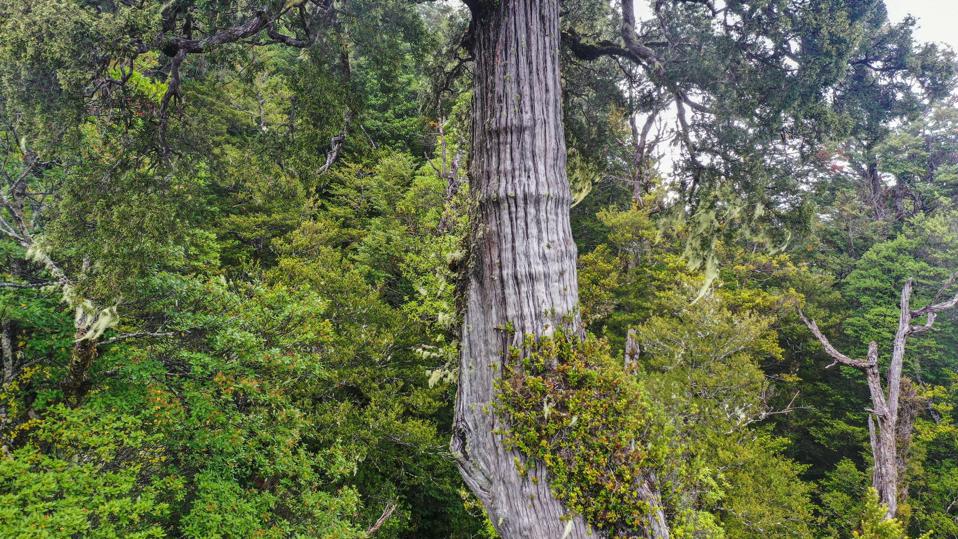Not many living organisms have been around long enough to witness the transition from the Ice Age tundra to the warm, human-dominated world we know today. But on a remote hillside in southern Chile, there is a Patagonian cypress known as the Alerce Milenario that may be as old as 5,000 years. Should its age be confirmed by ongoing studies, it would secure a spot among the oldest living trees on Earth.
This ancient cypress has withstood volcanic eruptions, glaciation cycles, colonial logging and climate change. It has lived longer than recorded human civilization itself. And despite everything, it continues to grow.
A Tree Born Before Written History
The Patagonian cypress (Fitzroya cupressoides) grows in the cool, wet forests of Chile and Argentina. It’s a relative of the redwoods, which are famous for towering over 200 feet tall and living thousands of years.
However, this particular tree — nicknamed Alerce Milenario (“the millennial larch”) or Gran Abuelo (“the great-grandfather”) — is something altogether different. Specifically, it has somehow lived through:
- Five glacial cycles
- The rise and fall of ancient civilizations
- The entire history of written language
- The warming and cooling pulses of the Holocene
It’s so old, in fact, that its earliest rings formed at a time when mammoths still roamed Siberia.
Why These Trees Live So Long
As research from Selbyana notes, long-lived trees have three essential traits that enable them to outlive their counterparts:
- Exceptional decay resistance. Their wood contains natural chemicals that slow down the process of rotting while also repelling insects. In Fitzroya cupressoides, this resin-rich heartwood is so durable that logged pieces are known to survive for centuries — even when left in seawater.
- Stable, cool climate. The temperate rainforests of Chile and Argentina are among the most stable on Earth. In turn, they offer cypresses like Alerce Milenario ample moisture and few lightning storms.
- Slow, deliberate growth. Trees that grow slowly produce much denser wood than those that grow faster. This dense wood, in turn, becomes almost like a suit of armor.
But the Patagonian cypress has an additional advantage: isolation. Much of the forest where the oldest individuals grow is remote, steep, and historically difficult for humans to access.
The Science Behind Its Age
Tree ages are typically measured by coring. This refers to the process of drilling a pencil-thin tube through the trunk in order to count their number growth rings. However, Gran Abuelo is so massive that its heartwood is inaccessible; even the most advanced of drills can’t reach the center.
Given this barrier, researchers have instead started to combine several partial cores, fragmented samples from fallen branches and growth-rate models. These resources, when compared with similar trees, have eventually enabled an estimation of its age. Current analyses suggest an age between 4,000 and over 5,300 years, making it a contender for the oldest tree in the world.
During its lifetime, this single cypress has endured the advance and retreat of Andean glaciers, massive volcanic eruptions throughout Patagonia, centuries of forest fires, as well as European colonization and widespread deforestation. And, still, it stands today.
The Ancient Giant’s Modern Threat
Today, paradoxically, the biggest threat to this ancient cypress is the sheer amount of interest that its age has garnered. The once-secluded area has drawn hikers, tourists and attention on social media. As such, increased foot traffic is increasingly compacting the soil around the tree’s roots, while also damaging the already fragile forest floor.
Park guards now monitor the area daily. Scientists urge the public to admire the tree from a distance to ensure that something which has survived five ice ages doesn’t meet its end through human curiosity.
After all, it wouldn’t be the first time an historic tree was felled due to human activity/ineptitude. The famed tree of Tenere lived for hundreds of years in the center of the Sahara desert before allegedly being struck and knocked over by a drunk desert driver.
Some organisms outlive civilizations. Some outlive epochs. The Alerce Milenario — if current research holds — has outlived eras of climate on Earth. It began as a seedling when the world felt like a different planet.
It isn’t just a tree; it’s a stamp of nature’s enduring presence, carved in wood.
Are you an animal lover who owns a pet? Take the science-backed Pet Personality Test to know how well you know your little friend.
Do you have an eye for nature photography? Join my Nature Photography Club and take your photos to the next level.

